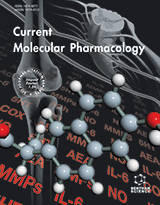Abstract
Discovery of novel cancer chemotherapeutics focuses on screening and identifying compounds that can target ‘cancer-specific’ biological processes while causing minimal toxicity to non-tumor cells. Alternatively, model organisms with highly conserved cancer-related cellular processes relative to human cells may offer new opportunities for anticancer drug discovery when combined with chemical screening. Some organisms used for chemotherapeutic discovery include yeast, Drosophila, and zebrafish which are similar in important ways relevant to cancer study but offer distinct advantages as well. Here, we describe these model attributes and the rationale for using them in cancer drug screening research.
Keywords: Anti-cancer drug discovery, Drosophila, HTS, model organism, yeast, zebrafish.
Current Molecular Pharmacology
Title:Anti-cancer Drug Discovery: Update and Comparisons in Yeast, Drosophila, and Zebrafish
Volume: 7
Author(s): Guangxun Gao, Liang Chen and Chuanshu Huang
Affiliation:
Keywords: Anti-cancer drug discovery, Drosophila, HTS, model organism, yeast, zebrafish.
Abstract: Discovery of novel cancer chemotherapeutics focuses on screening and identifying compounds that can target ‘cancer-specific’ biological processes while causing minimal toxicity to non-tumor cells. Alternatively, model organisms with highly conserved cancer-related cellular processes relative to human cells may offer new opportunities for anticancer drug discovery when combined with chemical screening. Some organisms used for chemotherapeutic discovery include yeast, Drosophila, and zebrafish which are similar in important ways relevant to cancer study but offer distinct advantages as well. Here, we describe these model attributes and the rationale for using them in cancer drug screening research.
Export Options
About this article
Cite this article as:
Gao Guangxun, Chen Liang and Huang Chuanshu, Anti-cancer Drug Discovery: Update and Comparisons in Yeast, Drosophila, and Zebrafish, Current Molecular Pharmacology 2014; 7 (1) . https://dx.doi.org/10.2174/1874467207666140702113629
| DOI https://dx.doi.org/10.2174/1874467207666140702113629 |
Print ISSN 1874-4672 |
| Publisher Name Bentham Science Publisher |
Online ISSN 1874-4702 |
 69
69
- Author Guidelines
- Bentham Author Support Services (BASS)
- Graphical Abstracts
- Fabricating and Stating False Information
- Research Misconduct
- Post Publication Discussions and Corrections
- Publishing Ethics and Rectitude
- Increase Visibility of Your Article
- Archiving Policies
- Peer Review Workflow
- Order Your Article Before Print
- Promote Your Article
- Manuscript Transfer Facility
- Editorial Policies
- Allegations from Whistleblowers
- Announcements
Related Articles
-
Antiinflammatory Activity of Melatonin in Central Nervous System
Current Neuropharmacology Anticancer Drug Combinations, How Far We can Go Through?
Anti-Cancer Agents in Medicinal Chemistry The Influence of Ionizing Radiation on Exosome Composition, Secretion and Intercellular Communication
Protein & Peptide Letters Clinical and <i>In Silico</i> Outcomes of the Expression of miR-130a-5p and miR-615-3p in Tumor Compared with Non-Tumor Adjacent Tissues of Patients with BC
Anti-Cancer Agents in Medicinal Chemistry Importance of Influx and Efflux Systems and Xenobiotic Metabolizing Enzymes in Intratumoral Disposition of Anticancer Agents
Current Cancer Drug Targets High Throughput Screening for Colorectal Cancer Specific Compounds
Combinatorial Chemistry & High Throughput Screening Novel Biomarkers of microRNAs in Gastric Cancer: An Overview from Diagnosis to Treatment
MicroRNA <sup>90</sup>Y-DOTA-Nimotuzumab: Synthesis of a Promising β− Radiopharmaceutical
Current Radiopharmaceuticals Recent Advances in the Development of Thioredoxin Reductase Inhibitors as Anticancer Agents
Current Drug Targets Understanding Molecular Pathways and Targets of Brachyury in Epithelial-mesenchymal Transition (EMT) in Human Cancers
Current Cancer Drug Targets Editorial (Thematic Issue: “Alkaloids in Nature: Synthesis, Isolation and Pharmacological Applications” Part 2)
Current Topics in Medicinal Chemistry Curcumin: Not So Spicy After All
Mini-Reviews in Medicinal Chemistry Patent Selections:
Current Biomarkers (Discontinued) Radiofluorinated Carbohydrates for Positron Emission Tomography
Current Topics in Medicinal Chemistry Opiates as Antidepressants
Current Pharmaceutical Design Editorial [Hot topic: Targeting Nitric Oxide for Tumor Therapy (Executive Editor: Antonio Contestabile)]
Current Pharmaceutical Design Lessons from Nature: Sources and Strategies for Developing AMPK Activators for Cancer Chemotherapeutics
Anti-Cancer Agents in Medicinal Chemistry Nanomedicine to Deal With Cancer Cell Biology in Multi-Drug Resistance
Mini-Reviews in Medicinal Chemistry Therapy Based on the Regulation of Thiol-dependent Redox Systems
Current Medicinal Chemistry Ceramide and Apoptosis: Exploring the Enigmatic Connections between Sphingolipid Metabolism and Programmed Cell Death
Anti-Cancer Agents in Medicinal Chemistry


























